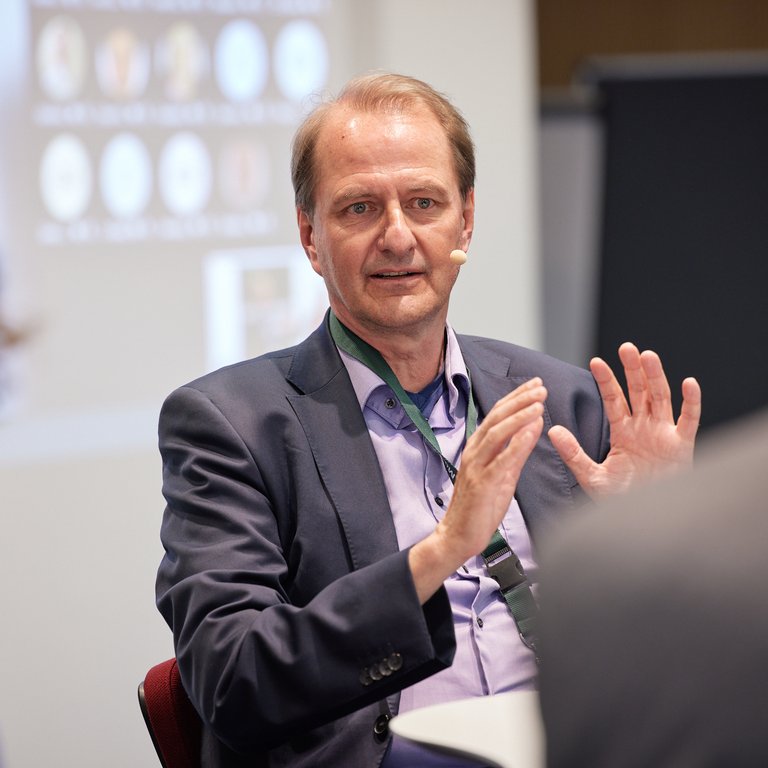
Not more than 2 degrees of global warming - But how?
Dialogue Forum on 24 May 2022, 19:00
Online and at Munich Re, Conference Room Europe, Giselastr. 21, 80802 Munich
properties.trackTitle
properties.trackSubtitle

If we want to prevent certain tipping points in the Earth system, such as the Greenland ice sheet melting irretrievably or the Amazon rainforest disappearing, we need negative emissions from the 2030s at the latest.
Policymakers are called upon
If we want to prevent certain tipping points in the Earth system, such as the Greenland ice sheet melting irretrievably or the Amazon rainforest disappearing, we need negative emissions from the 2030s at the latest," Messner is convinced. Depending on the model, we would have to filter six to ten gigatonnes of CO2 per year out of the atmosphere globally. That is enormous, considering that mankind currently emits around 40 gigatonnes per year. Given the size of the problem, we need a strategy and the right political course, both of which are currently lacking.
Prof. Dr. Andreas Oschlies from GEOMAR Helmholtz Centre for Ocean Research in Kiel outlined the possibilities for removing CO2 from the atmosphere: E. g. by physical means, by extracting the CO2 at the source, compressing it and pumping it into safe storage sites, for example under the sea. "Norway has been practising this for 25 years, and as far as we can tell, it works well." Chemically, CO2 can be reduced by binding CO2 dissolved in the oceans with finely ground basalt rock. The weathering of rocks also plays an important role. Biologically, the process works through reforestation, since biomass is nothing more than CO2 that has become solid.
Oceans as promising carbon sinks
However, the potential of the individual options varies greatly. Even if we avoid 90 per cent of our emissions, we would have to afforest the area of Russia for the remaining ten per cent if we only used biological removal. This is utopian, also because forested areas are dark and can thus store more heat and would thus actually contribute to further warming, despite the CO2 storage. Chemically, each person would have to spread five to ten kilograms of rock dust on soils and fields every day to neutralise the three kilograms of CO2 produced per capita in Germany. "We quickly run into difficulties here because the land areas are limited," the expert for marine biogeochemistry pointed out. On the other hand, he said, the ocean, which already binds about 60 times as much CO2 as our atmosphere, is a promising carbon sink under certain conditions.
"I have a stomach-ache about underground storage of CO2," admitted Dr. Nina Scheer, climate protection and energy policy spokesperson of the SPD parliamentary group. Not without reason, she said, many federal states had decided against CCS (carbon capture and storage, i.e. storing carbon dioxide underground). "You need pipelines for this, you have to find suitable storage sites and, as with nuclear repositories, you have to take possible dangers into account," said the MP, explaining her scepticism.
Creating win-win situations

If win-win situations can be created and new business models developed in the field of CO2 avoidance or removal, people will better accept the technologies that are yet not widespread.
Prof. Dr. Anita Engels, Professor of Sociology at the University of Hamburg, was convinced that only if the political pressure was great enough would something be done about negative emissions. It is also important to set up support programmes. "This worked very well with the energy transition with the feed-in tariff, in that the switch to renewable energies was supported by millions of people." If it is possible to create win-win situations again and to develop new business models, be it in the area of CO2 avoidance or extraction, people will accept the technologies that are still not very widespread, Engels believes.
Relying on natural CO2 sinks such as optimally managed forests may be sufficient for residual German emissions, but will not be enough to solve the climate problem globally, according to UBA President Messner: "Studies show that nature-based solutions cannot filter more than two to three gigatonnes annually from the atmosphere." In addition, natural sinks are currently being weakened rather than strengthened. "The Amazon rainforest, for example, has now become an emitter of CO2." Therefore, safe storage sites for CO2 must also be found in Germany and worldwide in order to have a fallback option if we need to act quickly, he demanded.
Many countries further ahead than Germany

If we set the wrong course on negative emissions, we run the risk of prolonging the fossil age with a 'business as usual' approach.
The discussion about technical solutions to remove CO2 from the atmosphere can also be counterproductive, as MP Scheer made clear: "If we set the wrong course on negative emissions, we run the risk of prolonging the fossil age with a 'business as usual' approach," she warned. "We can counter the concern that we are keeping fossil industries alive with regulations, for example by setting up separate accounts for positive and negative emissions," ocean researcher Oschlies countered. He also pointed out that many countries in Europe, such as Great Britain or the Netherlands, are much further ahead than we are in terms of negative emissions. He considers the argument of a prolonged fossil age merely an alibi function to remain inactive. "Waiting is the wrong strategy, this way we continue to spread our CO2 waste all over the world. Doing without final storage for CO2 is neither responsible nor ethically justifiable; after all, we don't do that with our chemical waste either," he clarified.
But why is Germany lagging behind other countries, when we have taken on a pioneering role in renewable energies? Sociologist Engels explained that structural reasons exist. "Car manufacturers are a major factor in all considerations of which direction to take, and there are powerful interest groups in German industry that steer the discussion in their favour."

Waiting is the wrong strategy, so we continue to spread our CO2 waste all over the world. Continuing without final storage for CO2 is neither responsible nor ethically justifiable. After all, we don't do that with our chemical waste either.
"Based on everything we know today, there is no scenario to keep global warming below two degrees without negative emissions," Messner concluded. Even if the technologies are theoretically available, a lot of research is still needed to set up the necessary infrastructure for CCS in the gigatonnes range, he said. "Precisely because we are still at the beginning in Germany, we need a political strategy and research funding."
We must not lie to ourselves that we are on the right path to climate neutrality, Engels added. Because one thing is clear: we must continue to focus fully on avoiding CO2 emissions. In addition, precisely because we will have residual emissions and are too slow in avoiding them, we must also plan CO2 removal processes on a large scale. Both together will hopefully lead to a future in which climate change remains manageable worldwide and societies can adapt to the consequences.
************************************


